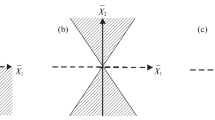Abstract
Thermodynamic analysis of models of liquid solutions is carried out on the basis of the concentration dependences of excess functions. Using the energy balance plane, the applicability region of the nonrandom two-liquid (NRTL) equation is determined and constraints on the equation parameters are imposed.
Similar content being viewed by others
REFERENCES
Walas, S.M., Phase Equilibria in Chemical Engineering, Boston: Butterworth, 1985. Translated under the title Fazovye ravnovesiya v khimicheskoi tekhnologii, Moscow: Mir, 1989.
Reid, R.C., Prausnitz, J.M., and Sherwood, T.K., The Properties of Gases and Liquids, New York: McGraw-Hill, 1977. Translated under the title Svoistva gazov i zhidkostei, Leningrad: Khimiya, 1982.
Platonov, V.M., Petlyuk, F.B., and Avet'yan, V.S., Analysis of the Wilson Equation for Describing the Nonideal Behavior of Binary Solutions, Teor. Osn. Khim. Tekhnol., 1971, vol. 5, no. 1, p. 122.
Baburina, L.V., Maklashina, N.S., and Platonov, V.M., Describing Azeotropy in Binary Systems in Terms of the Wilson Equation, Teor. Osn. Khim. Tekhnol., 1992, vol. 26, no. 1, p. 116.
Baburina, L.V. and Maklashina, N.S., Qualitative Analysis of a Model of the Liquid–Liquid–Vapor Equilibrium in Terms of the NRTL Equation, Zh. Fiz. Khim., 1997, vol. 71, no. 4, p. 637.
Baburina, L.V. and Maklashina, N.S., Modeling of Liquid–Liquid–Vapor Equilibria for Binary and Multicomponent Systems, Zh. Fiz. Khim., 1997, vol. 71, no. 1, p. 86.
Mato, R., Mato, F.A., and Mato, F., Behavior of the LEMF Equation Vapor–Liquid Equilibrium Data Treatment of System with Negative Deviations From Ideality, Fluid Phase Equil., 1991, vol. 68, p. 115.
Nicolaides, G.L. and Eckert, C.A., Optimal Representation of Binary Liquid Mixtures Nonidealities, Ind. Eng. Chem. Fundam. Res., 1978, vol. 17, no. 4, p. 331.
Hanks, R.W., Tan, R.L., and Christensen, J.J., Limits on the Simultaneous Correlation of GE and HE Data by the NRTL, LEMF and Wilson's Equations, Thermochim. Acta, 1978, vol. 23, p. 41.
Gennero de Chialvo, M.R. and Chialvo, A.C., Determination of the Function F(H E, G E) = 0 for Wilson, NRTL, LEMF, and UNIQUAC Equations, Ind. Eng. Chem. Res., 1994, vol. 33, no. 4, p. 1035.
Hanks, R.W., Gupta, A.C., and Christensen, J.J., Calculation of Isothermal Vapor–Liquid Equilibrium Data for Binary Mixtures from Heats of Mixing, Ind. Eng. Chem. Fundam. Res., 1971, vol. 10, no. 3, p. 504.
Tan, R.L., Hanks, R.W., and Christensen, J.J., The Prediction of Isothermal Phase Equilibria for Nonideal Multicomponent Mixtures from Heats of Mixing, Thermochim. Acta, 1977, vol. 21, p. 157.
Pando, C., Renuncio, J.A.R., Hanks, R.W., and Christiesen, J.J., The Prediction of Vapour-Liquid Equilibrium from Heat of Mixing Data of Binary Hydrocarbon–Ether and Hydrocarbon–Aldehyde Mixtures, Thermochim. Acta, 1983, vol. 62, p. 113.
Garsia Calzon, J.A., Pando, C., and Renuncio, J.A.R., Simultaneous Correlation of Vapor–Liquid Equilibrium and Excess Enthalpies for Binary Mixtures of n-Hexane and n-Octane with Hexane Isomers, Thermochim. Acta, 1986, vol. 106, p. 219.
Raeva, V.M., Behavior and Separation of Azeotropic Mixtures at a Varied Pressure, Cand. Sci. (Eng.) Dissertation, Moscow: Lomonosov State Academy of Fine Chemical Technology, 1998.
Bittrikh, G.-I., Gaile, A.A., Lempe, D., et al., Razdelenie uglevodorodov s ispol'zovaniem selektivnykh rastvoritelei (Separation of Hydrocarbons Using Selective Solvents), Leningrad: Khimiya, 1987.
Serafimov, L.A., Frolkova, A.K., and Raeva, V.M., Analysis of the Entire Space of Excess Functions of Mixing for Binary Solutions, Teor. Osn. Khim. Tekhnol., 1996, vol. 30, no. 6, p. 611.
Frolkova, A.K., Theoretical Foundations of the Separation of Multicomponent Multiphase Mixtures Using Functional Complexes, Doctoral (Eng.) Dissertation, Moscow: Lomonosov State Academy of Fine Chemical Technology, 2000.
Raeva V.M., Frolkova A.K., and Ponomarev V.N., Behavior of Binary Heteroazeotropes under Varied External Conditions, Zh. Fiz. Khim., 2000, vol. 74, no. 7, p. 1194.
Author information
Authors and Affiliations
Rights and permissions
About this article
Cite this article
Serafimov, L.A., Frolkova, A.K. & Raeva, V.M. Thermodynamic Analysis of the NRTL Model Using the Concentration Dependences of Excess Functions. Theoretical Foundations of Chemical Engineering 36, 353–359 (2002). https://doi.org/10.1023/A:1019899600086
Issue Date:
DOI: https://doi.org/10.1023/A:1019899600086



